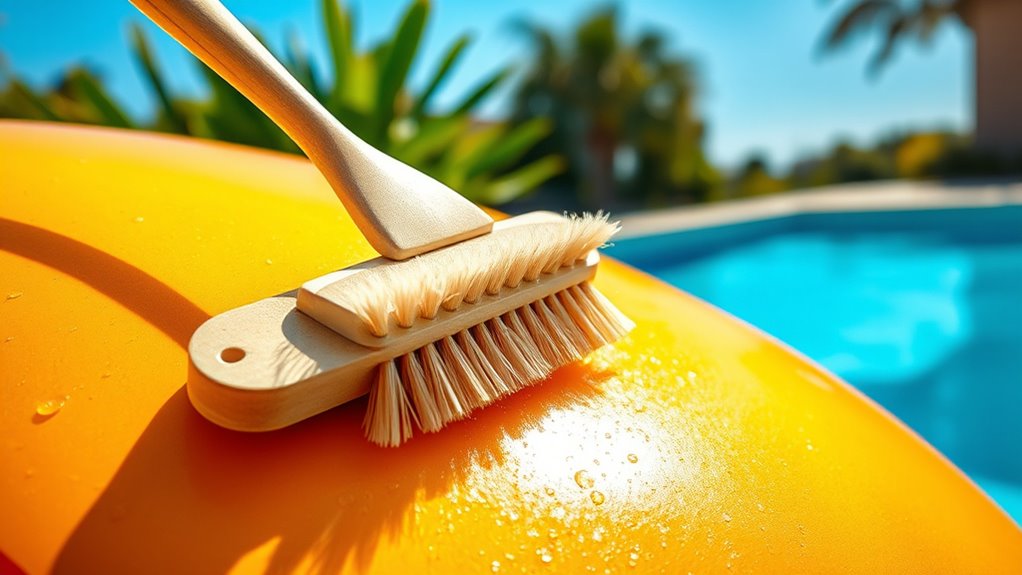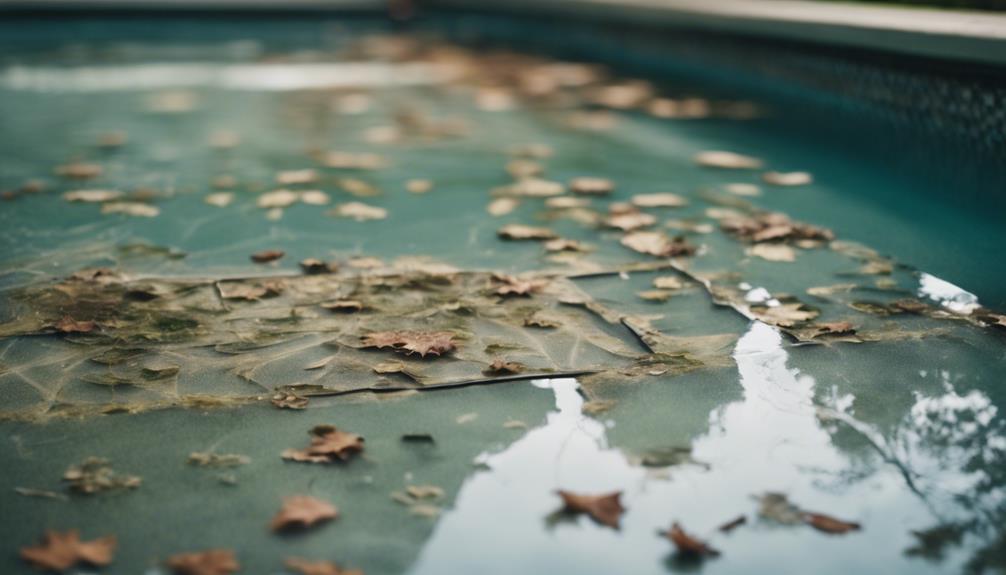To keep your inflated float surfaces in top condition, regularly clean them using a mild soap and water solution, avoiding harsh chemicals or abrasives. Wipe down all areas, especially seams and creases, and rinse thoroughly to remove residue. Dry the surface completely and store it in a cool, shaded spot to prevent sun damage and mildew growth. Regular inspections for punctures or tears help you catch issues early. If you continue, you’ll discover expert tips for long-lasting maintenance.
Key Takeaways
- Regularly inspect floats for damage, punctures, or tears and repair promptly to prevent further deterioration.
- Clean surfaces with mild soap and water, avoiding harsh chemicals or abrasive scrubbers to prevent surface damage.
- Dry floats thoroughly after use to prevent mildew growth, especially in seams and creases.
- Apply UV-resistant coatings or store floats in shaded areas to protect against sun damage and prolong lifespan.
- Keep floats in a cool, dry storage space when not in use, and perform routine maintenance for optimal performance.

Cleaning and maintaining inflated float surfaces is essential to guarantee their longevity and ideal performance. When you invest in these floats, you want them to remain vibrant, safe, and functional for as long as possible. One of the most effective ways to do this is by ensuring they are protected from UV damage and mildew buildup. UV rays from the sun can cause the material to weaken, fade, and crack over time, so providing UV protection is key. You can do this by applying a UV-resistant coating or storing your floats in shaded areas when they’re not in use. This simple step shields the surface from prolonged sun exposure, helping to preserve the integrity of the material.
Mildew prevention is equally critical, especially if your floats are stored in damp or humid environments. Mildew not only stains the surface but can also degrade the material, making it less durable. To prevent this, always dry your floats thoroughly after use and before storing them. Wipe down the surface with a clean cloth and let it air dry in a well-ventilated area. Using a mild disinfectant solution or a mixture of water and vinegar can also help kill mildew spores on contact. Regularly inspecting your floats for signs of mold or mildew allows you to address issues early before they spread or cause damage.
When it’s time to clean the surface, avoid harsh chemicals or abrasive scrubbers that could damage the material. Instead, use a gentle cleaning solution—mix a small amount of mild soap with water—and scrub with a soft cloth or sponge. Pay special attention to seams and creases where dirt and grime can accumulate. Rinsing thoroughly with clean water to remove any soap residue, which could otherwise cause damage or attract more dirt. After cleaning, make sure the surface is completely dry before storing or using the float again. Proper maintenance also means checking for any signs of wear or punctures regularly. Small tears can quickly escalate if left untreated, so patch them immediately with appropriate repair kits. Keep your floats in a cool, dry place when not in use, away from direct sunlight and extreme temperatures. This not only extends their lifespan but also ensures they stay safe and in top condition for your enjoyment. By incorporating UV protection, preventing mildew, and following a consistent cleaning routine, you can considerably extend the life of your inflated float surfaces while keeping them looking and performing their best. Additionally, choosing the right cleaning agents can help maintain the color fidelity of your floats, ensuring they look as good as new over time.
Frequently Asked Questions
How Often Should I Inspect My Inflated Float Surfaces?
You should inspect your inflated float surfaces weekly, following the inspection frequency guidelines for inflatable material durability. Regular checks help identify leaks, tears, or wear early, preventing bigger issues. Look for signs of damage and verify all seams are intact. Consistent inspections keep your inflatable surfaces safe and prolong their lifespan, especially if used frequently or in harsh environments. Staying proactive with inspections is key to maintaining their quality and safety.
Can I Use Harsh Chemicals to Clean Inflatables?
Did you know that using harsh chemicals can damage inflatable surfaces and void warranties? You shouldn’t use harsh chemicals to clean inflatables because of chemical safety concerns. Instead, opt for gentle cleaning agents like mild soap and water. Harsh chemicals can cause material deterioration and reduce lifespan. Always check manufacturer guidelines and avoid abrasive or toxic cleaning agents to keep your inflatables safe, durable, and looking their best.
What Should I Do if My Inflatable Develops a Leak?
If your inflatable develops a leak, start with leak detection by listening for hissing sounds or applying soapy water to spot bubbles. Once you locate the leak, perform a patch repair using a suitable patch kit designed for inflatables. Clean the area thoroughly before applying the patch, then follow the instructions carefully. Regular maintenance and prompt repairs will prolong your inflatable’s lifespan and keep it safe for continued use.
Are There Specific Storage Tips to Prevent Damage?
Storing your inflatable is like tucking a fragile treasure away, so handle it with care. Use proper storage by ensuring it’s clean, dry, and deflated before placing it in a cool, dry place away from direct sunlight. Avoid sharp objects and extreme temperatures to prevent damage. Proper storage keeps your float surface in top shape, ready for your next adventure, and helps prevent tears, punctures, or weakening over time.
How Do I Remove Stubborn Stains From Inflatables?
To remove stubborn stains from inflatables, start by gently scrubbing the area with a soft cloth or sponge soaked in a mixture of mild soap and water. For tougher stains, apply a small amount of baking soda or a specialized stain remover, then let it sit for a few minutes. Use a soft brush to scrub lightly, avoiding damage. Rinse thoroughly with clean water and let it air dry.
Conclusion
By regularly cleaning and maintaining your inflated float surfaces, you’re not just preserving their appearance—you’re safeguarding a tiny slice of paradise. Think of your float as a delicate gem that needs love and care to shine forever. Ignore these steps, and it’s like watching a masterpiece fade into obscurity. With just a little effort, you’ll keep your float looking stunning for years, making every splash feel like a luxurious escape from everyday life.









